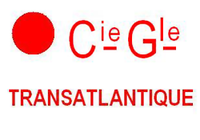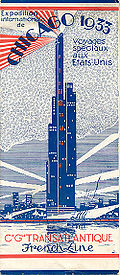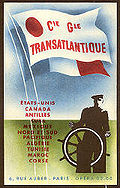
Compagnie Générale Transatlantique
Encyclopedia

Crimean War
The Crimean War was a conflict fought between the Russian Empire and an alliance of the French Empire, the British Empire, the Ottoman Empire, and the Kingdom of Sardinia. The war was part of a long-running contest between the major European powers for influence over territories of the declining...
of 1856. The company's first vessel, the SS Washington, had its maiden voyage on 15 June 1864. Other than operating ocean liners, the company also had a significant fleet of freighters
Cargo ship
A cargo ship or freighter is any sort of ship or vessel that carries cargo, goods, and materials from one port to another. Thousands of cargo carriers ply the world's seas and oceans each year; they handle the bulk of international trade...
. The company survived both World Wars, but the development of jet travel doomed its mainstay passenger liner business. During 1977 the company merged with the Compagnie des Messageries Maritimes to form the Compagnie Générale Maritime. During 1996 the company Compagnie Générale Maritime merged to form the CMA CGM
CMA CGM
CMA CGM S.A. is a French container transportation and shipping company, headed by Jacques Saadé. It is the third largest container company in the world, using 200 shipping routes between 400 ports in 150 different countries...
.
History
During 1855, the Péreire brothersPéreire brothers
The Péreire brothers were prominent 19th century financiers in Paris, France who were rivals of the Rothschilds. Like the Rothschilds, they were Jews, but unlike them the Péreire brothers were Sephardi Jews of Portuguese origin....
, Emile and Isaac, created the Compagnie Générale Maritime, which later became the Compagnie Générale Transatlantique. They were already the owners of the Société Générale de Crédit Mobilier
Crédit Mobilier
Crédit Mobilier was a French banking company, and one of the most important financial institutions of the world during the 19th century. It had a major role in the financing of numerous railroads and other infrastructure projects in Europe, North Africa and the Middle East by mobilizing the savings...
, which became the main shareholder. Five years later they signed an agreement with the French government. The company contracted to create a fleet and to provide liner service and carry mail for 20 years on the following routes: Le Havre - New York with calls at Brest, Saint-Nazaire, and the Isthmus of Panama, with 3 additional services for Guadeloupe, Mexico and Cayenne. In return, the government would provide the company with an annual subsidy.
During 1861 Compagnie Générale Maritime changed its name to the Compagnie Générale Transatlantique. The Pereire brothers also established a shipyard at Penhoët, near Saint-Nazaire. The next year the first trip to the West Indies and Mexico was made by the ship Louisiane. Two years later the New York - Le Havre line service was begun, with the paddle-steamer Washington providing postal service. During 1867 the company switched from using paddle wheels to using propellers for its vessels, partly because they were more fuel efficient.
An economic and financial crisis during 1868 forced the Pereire brothers to file a petition of bankruptcy and to resign from the company's board. However, the company survived.
Technical progress continued and the company modified its vessels to transport more goods. Still, during 1873 the line suffered its first major accident. The Ville du Havre collided with the sailing ship Loch Earn, with a loss of life of about 226 people.
During 1879 the French government awarded the company the concession for postal services for the Mediterranean. That same year the company incorporated. Between 1882 and 1884 the government renewed the earlier fleet and postal agreements.
During 1886 SS La Bourgogne
SS La Bourgogne
SS La Bourgogne was built in 1885 by Forges & Chantiers de la Mediteranee, La Seyne for the Compagnie Generale Transatlantique . She was a 7,395 gross ton vessel, length 494.4ft x beam 52.2ft, two funnels, four masts, iron and steel construction, single screw and a speed of 17 knots. There was...
traveled the le Havre - New York transit in a little more than 7 days. This gave the company first place in the New York postal service, and began a competition for the record in the trans-Atlantic run. During 1894 the company offered the first cruise for American passengers when La Touraine initiated service from New York to Constantinople.
Between 1897 and 1904, European competition intensified and the company suffered two major maritime disasters. The Ville de Saint-Nazaire had to be abandoned at sea during 1897 and La Bourgogne sank with 568 passengers during 1898. Furthermore, labor strife developed as strikes came to affect all ports and all staff. The strikes continued until 1923.
During 1904 Jules Charles-Roux became president and instituted a reorganization. The company re-oriented its strategy to emphasize the quality of life aboard ship rather than racing against time. The next year it initiated Le Havre - New York cargo service.
The company did not become a major participant of the trans-Atlantic ocean liner trade until after World War I. During 1907 and 1908, when immigration to the United States
United States
The United States of America is a federal constitutional republic comprising fifty states and a federal district...
was greatest, the company's share of the market was a mere 10%. In line with its strategy, the company did not have ships of either great speed or size, but instead became renowned during the early 20th century for its luxuriously appointed liners. The most notable of these early ships was the SS France
SS France (1912)
The SS France was a French ocean liner which sailed for the Compagnie Générale Transatlantique, colloquially known as CGT or the "French Line". She was the only French liner to have the famous Four stackers, she was later dubbed the Versailles of the Atlantic, a reference to her décor which...
, which began service during 1912.
During World War I
World War I
World War I , which was predominantly called the World War or the Great War from its occurrence until 1939, and the First World War or World War I thereafter, was a major war centred in Europe that began on 28 July 1914 and lasted until 11 November 1918...
the company transformed its vessels into warships, hospital vessels and troopships. By the end of the war, the company had lost a third of the fleet. Still, the company recovered during the post-war period, with several famous ships beginning service. During 1927, the SS Ile de France
SS Ile de France
The SS Ile de France was a French ocean liner built in Saint-Nazaire, France for the Compagnie Générale Transatlantique. The ship was the first major ocean liner built after the conclusion of World War I and was the first liner ever to be decorated entirely with designs associated with the Art Deco...
, the first ship to be styled in Art Deco
Art Deco
Art deco , or deco, is an eclectic artistic and design style that began in Paris in the 1920s and flourished internationally throughout the 1930s, into the World War II era. The style influenced all areas of design, including architecture and interior design, industrial design, fashion and...
, had its maiden voyage.
The company also diversified. During 1919 it introduced the first tourist motor car circuit in North Africa and during 1925 it created the Société des Voyages et Hôtels Nord-Africains (S.V.H.N.A.).


Great Depression
The Great Depression was a severe worldwide economic depression in the decade preceding World War II. The timing of the Great Depression varied across nations, but in most countries it started in about 1929 and lasted until the late 1930s or early 1940s...
caused the company to suffer a significant decrease of profits as costs increased and passenger numbers decreased. The company responded by decommissioning vessels and discontinuing unprofitable routes. A generous government subsidy enabled the company, during 1935, to finance the construction its most famous vessel, the SS Normandie
SS Normandie
SS Normandie was an ocean liner built in Saint-Nazaire, France for the French Line Compagnie Générale Transatlantique. She entered service in 1935 as the largest and fastest passenger ship afloat; she is still the most powerful steam turbo-electric-propelled passenger ship ever built.Her novel...
. At the time of completion, the ship was the largest in the world and also the fastest, winning the Blue Riband
Blue Riband
The Blue Riband is an unofficial accolade given to the passenger liner crossing the Atlantic Ocean in regular service with the record highest speed. The term was borrowed from horse racing and was not widely used until after 1910. Under the unwritten rules, the record is based on average speed...
from the Italian liner, the SS Rex
SS Rex
The SS Rex was an Italian ocean liner launched in 1931. It held the westbound Blue Riband between 1933 and 1935. Originally built for the Navigazione Generale Italiana as the SS Guglielmo Marconi, its state-ordered merger with the Lloyd Sabaudo line meant that the ship sailed for the newly created...
. Its Art Deco interior and streamlined hull design were famous. It won the Blue Ribbon trophy for its first voyage with a speed of 30 knots. However, it was never a commercial success and a fire during 1942 ended its career.
During 1939-1940, at the beginning of World War II
World War II
World War II, or the Second World War , was a global conflict lasting from 1939 to 1945, involving most of the world's nations—including all of the great powers—eventually forming two opposing military alliances: the Allies and the Axis...
, the company was subject to mobilization of more than a third of the staff. The Department of Shipping & Maritime Transport chartered or requisitioned the company's ships. The company also received 95 vessels to manage for the war effort. By 1946, the loss of several vessels due to the war had diminished the company's fleet, though the company was able to acquire several Liberty ship
Liberty ship
Liberty ships were cargo ships built in the United States during World War II. Though British in conception, they were adapted by the U.S. as they were cheap and quick to build, and came to symbolize U.S. wartime industrial output. Based on vessels ordered by Britain to replace ships torpedoed by...
s. The company also acquired Liberté, the former German liner SS Europa
SS Europa (1930)
The SS Europa was a German built ocean liner constructed for the Norddeutsche Lloyd line to work the transatlantic sea route...
, which France
France
The French Republic , The French Republic , The French Republic , (commonly known as France , is a unitary semi-presidential republic in Western Europe with several overseas territories and islands located on other continents and in the Indian, Pacific, and Atlantic oceans. Metropolitan France...
had claimed as reparations.
Passenger traffic grew post-war, but the beginning of commercial air travel during 1958 was a disaster for the French Line's passenger ships. Despite the launch of a new flagship, the 66,000 ton SS France
SS France (1961)
SS France was a Compagnie Générale Transatlantique ocean liner, constructed by the Chantiers de l'Atlantique shipyard at Saint-Nazaire, France, and put into service in February 1962...
during 1961, passenger demand decreased as no ship could match the convenience of airplane flights that could transport passengers in a matter of hours over a distance that by ship would take several days. The ocean liner fleet became dependent on government subsidies, which were finally ended during 1974. The fleet was subsequently hulked.
France was laid up until 1979 when the Norwegian Cruise Line
Norwegian Cruise Line
Norwegian Cruise Line is a company operating cruise ships, headquartered in unincorporated Miami-Dade County, Florida. It began operations in 1966 under the name Norwegian Caribbean Line. The company is best known for its Freestyle Cruising concept, which means that there are no set times or...
bought it and renamed it Norway. During 2008, Norway was beached at Alang, India
India
India , officially the Republic of India , is a country in South Asia. It is the seventh-largest country by geographical area, the second-most populous country with over 1.2 billion people, and the most populous democracy in the world...
and broken for scrap.
During 1977 the company merged with the Compagnie des Messageries Maritimes to form the Compagnie Générale Maritime.
Vessels
CGT Ships included:(1899), munitions ship that exploded in the 1917 Halifax Explosion
Halifax Explosion
The Halifax Explosion occurred on Thursday, December 6, 1917, when the city of Halifax, Nova Scotia, Canada, was devastated by the huge detonation of the SS Mont-Blanc, a French cargo ship, fully loaded with wartime explosives, which accidentally collided with the Norwegian SS Imo in "The Narrows"...
. (1910) formerly SS Farnworth, bought and renamed in 1926, sold in 1934 and torpedoed in 1940 as SS Empire Conveyor (1917), sold to Counties Ship Management
Counties Ship Management
Counties Ship Management Co. Ltd. was an ocean-going merchant shipping company based in the United Kingdom. During the Second World War CSM merchant ships made a substantial contribution to supplying the British war effort, at a cost of 13 ships lost and 163 officers and men killed.-Founding of...
in 1934 and renamed SS Bury Hill, wrecked off the Senegal
Senegal
Senegal , officially the Republic of Senegal , is a country in western Africa. It owes its name to the Sénégal River that borders it to the east and north...
ese coast in 1936
- SS De GrasseRMS Empress of Australia (1924)SS De Grasse was an ocean liner built in 1920-1924 by Cammell Laird, Birkenhead, United Kingdom for the Compagnie Generale Transatlantique, and launched in February 1924.-Canadian Pacific:...
(1924-1953), renamed the RMS Empress of Australia by Canadian Pacific Steamships (1932–42), re-named USS Lafayette by the US Navy; damaged beyond repair by fire in New York (1945), ran agroud 1945, scrapped 1947. (formerly SS Europa of North German Lloyd) (1961) (later sold to Norwegian Cruise LineNorwegian Cruise LineNorwegian Cruise Line is a company operating cruise ships, headquartered in unincorporated Miami-Dade County, Florida. It began operations in 1966 under the name Norwegian Caribbean Line. The company is best known for its Freestyle Cruising concept, which means that there are no set times or...
and re-named SS Norway.)
Further reading
- Miller, William H. Jr., The First Great Ocean Liners in Photographs, 1984, Dover
- Fox, Robert, Liners, the Golden Age, 1999, Könemann
- McAuley, Robert, The Liners, 1997, Boxtree
- Maddocks, Melvin, The Great Liners, 1978, Time-Life
External links
- Passenger Lists of the CGT French Line
- Official website
- French Lines
- The Last Ocean Liners - French Line - trade routes and ships of the French Line during the 1960s and 1970s.

